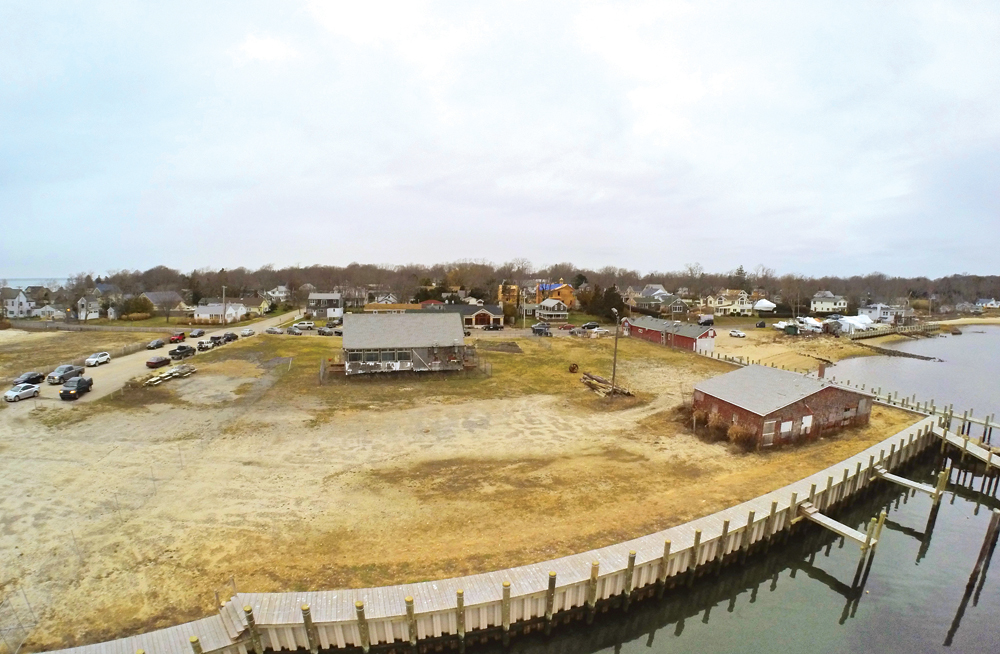A look back at the Galley Ho’s remarkable history

Its location has changed at least four times in less than a century, but one thing pretty much has stayed the same. Throughout its history, the building that’s become known locally as the Galley Ho has served the North Fork food industry in some capacity.
At least, when it wasn’t vacant, as it is today.
From the 1940s into the 21st century, it was a place where locals and visitors to New Suffolk could snack on seafood and have a drink. From the 19th century until before World War II, the simple rectangular structure was involved in the wholesale side of the food business — specifically, making oyster barrels.
Despite its age and precarious location near the water, it managed to survive the Hurricane of 1938, the Perfect Storm and, most recently, Superstorm Sandy, among other weather events.
The building’s current owner, the nonprofit New Suffolk Waterfront Fund, will soon break ground on a project designed to reclaim its history by rebuilding it as a restaurant and lifting it to ensure that it survives the many storms yet to come.
In light of the impending construction — and a very public battle this year between locals over the redevelopment plan — The Suffolk Times set out to document the rich history of this unassuming yet remarkable building.
THE OLD COOPERAGE
Reports on the age of the Galley Ho vary, but it’s believed to have been built in the late 1800s, at the height of New Suffolk’s booming oyster industry, said Cutchogue-New Suffolk Library historian Mariella Ostroski, who helped the newspaper compile a timeline for the building.
Initially owned by the Radell Oyster Company, it was used to manufacture oyster barrels in which to ship the bounty of shellfish that was raked in from Cutchogue Harbor — a purpose it served for several decades. The structure originally stood at the intersection of Jackson and Second streets, about a block and a half south and one block west of its location today. It remained there as a working industrial building into the 1940s, when the oyster and fishing industry in New Suffolk petered out and there was no longer demand for such a cooperage. But the structure persisted.
A PLACE TO EAT
The building got its start as an eatery in the early 1940s, when Charlie Dompke purchased the barrel-making facility and transformed it into Dompke’s restaurant. Described as a luncheonette, Dompke’s was popular among New Suffolk fishermen, Ms. Ostroski said.
In 1943, Elsie Fench of New Suffolk purchased the building and moved it closer to her home, near what is now the southwest corner of First and Jackson streets, at New Suffolk Town Beach. Her bayfront diner was called Fench’s, but was known affectionately among locals as the Coney Island Building, or simply Coney Island. It wasn’t until 1963 that Southold Town acquired land and Ms. Fench sold the building to Commander Arthur Kenniff, who already owned the 3.4-acre North Fork Shipyard property to the north. He moved the building to his First Street shipyard, across from what’s now Legends Restaurant. That’s where the structure sits today, although it was shifted about 100 feet closer to First Street after Superstorm Sandy.
The waterfront property surrounding the building today has its own interesting history. Until the 1980s it was the site of the North Fork Shipyard, but from 1897 to 1905 it served as the port where The Holland Torpedo Company conducted trials of the U.S. Navy’s first modern commissioned submarine, the USS Holland.
The building became the Galley Ho Restaurant in April 1974, when Dean Blaikie, then just 23, began renting the space from Cmdr. Kenniff. Mr. Blaikie renovated the building’s interior, adding a modern kitchen and a fireplace that allowed the restaurant to be open year round for the first time, according to an article in The Tides, a now-defunct publication that served only New Suffolk.
A 1983 advertisement in The Suffolk Times touted the Galley Ho’s fresh seafood dinners of mussels, lobster, clams, oysters and soft-shell crab.
“It was quite a popular place to hang out,” recalled Ms. Ostroski. “Everyone knew it was the spot to be.”







